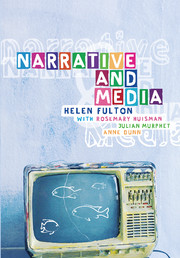Book contents
- Frontmatter
- Contents
- Figures and tables
- Contributors
- Acknowledgements
- 1 Introduction: the power of narrative
- Part 1 The basics of narrative theory
- Part 2 Film as narrative and visual mode
- 4 Stories and plots
- 5 Narrative time
- 6 Narrative voice
- 7 Point of view
- 8 Novel to film
- 9 Film narrative and visual cohesion
- Part 3 Television: narratives and ideology
- Part 4 Radio and print journalism
- Part 5 Popular print culture
- Glossary
- Bibliography
- Index
4 - Stories and plots
Published online by Cambridge University Press: 05 June 2012
- Frontmatter
- Contents
- Figures and tables
- Contributors
- Acknowledgements
- 1 Introduction: the power of narrative
- Part 1 The basics of narrative theory
- Part 2 Film as narrative and visual mode
- 4 Stories and plots
- 5 Narrative time
- 6 Narrative voice
- 7 Point of view
- 8 Novel to film
- 9 Film narrative and visual cohesion
- Part 3 Television: narratives and ideology
- Part 4 Radio and print journalism
- Part 5 Popular print culture
- Glossary
- Bibliography
- Index
Summary
There are many ways to think about film as a medium; its narrative properties represent only one component of a very complex whole. For example, it would be perfectly legitimate to approach film from its technological aspect, or to consider its function in sustaining a certain political culture, or to concentrate on its pictorial aesthetic qualities, or on its musical, rhythmic or chromatic properties. Nevertheless, both within the purview of this book, and more generally in the way we tend to think about and discuss the medium, films are predominantly considered as narrative forms. Indeed, it would be possible to contend that film was the dominant narrative medium of the twentieth century; a fact not without its own interesting history, some of which we will glance at below.
As a narrative medium, film – like other narrative media: epics, novels, dramas, operas and the various media considered in this book – has established many interlocking conventions to make its storytelling comprehensible. Many of these conventions concern the unique art of editing: the splicing together of different shots to make one coherent narrative whole. But other conventions have to do with how the image is composed ‘within the frame’ of any given shot. Traditionally, these two distinct areas in film aesthetics are known as, respectively, montage and mise en scène.
- Type
- Chapter
- Information
- Narrative and Media , pp. 47 - 59Publisher: Cambridge University PressPrint publication year: 2005



